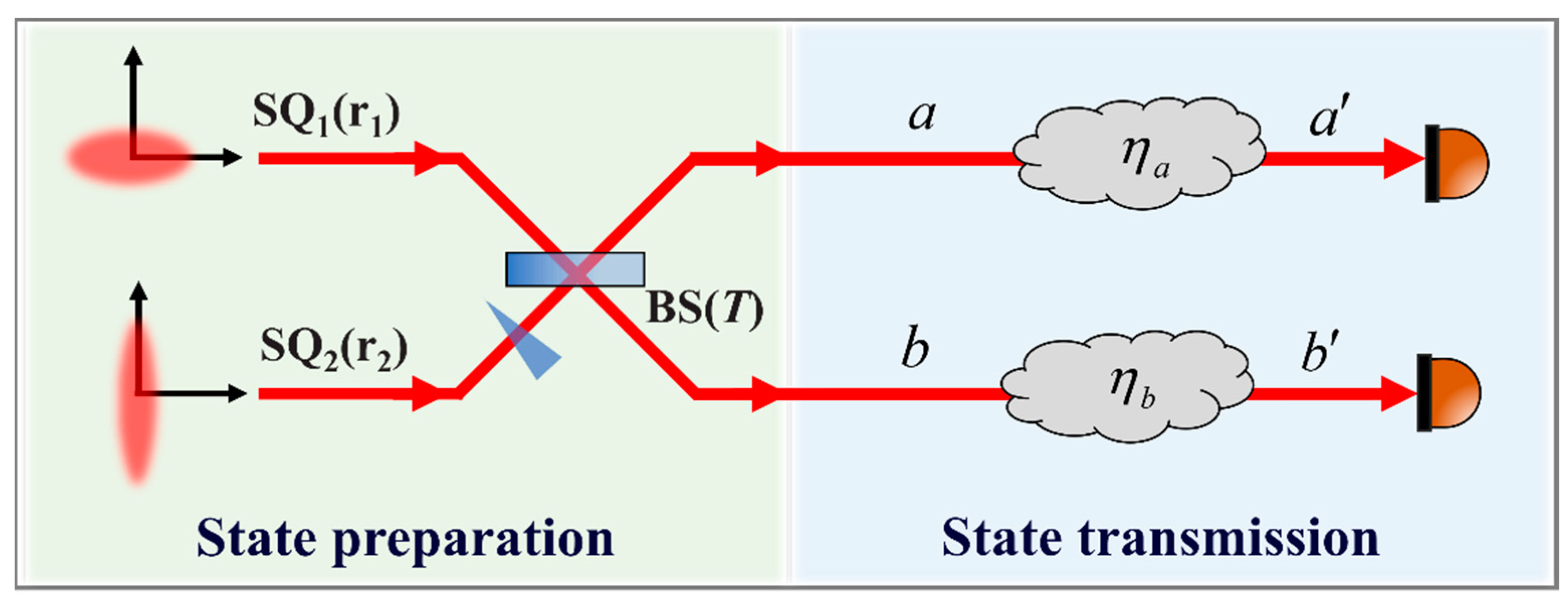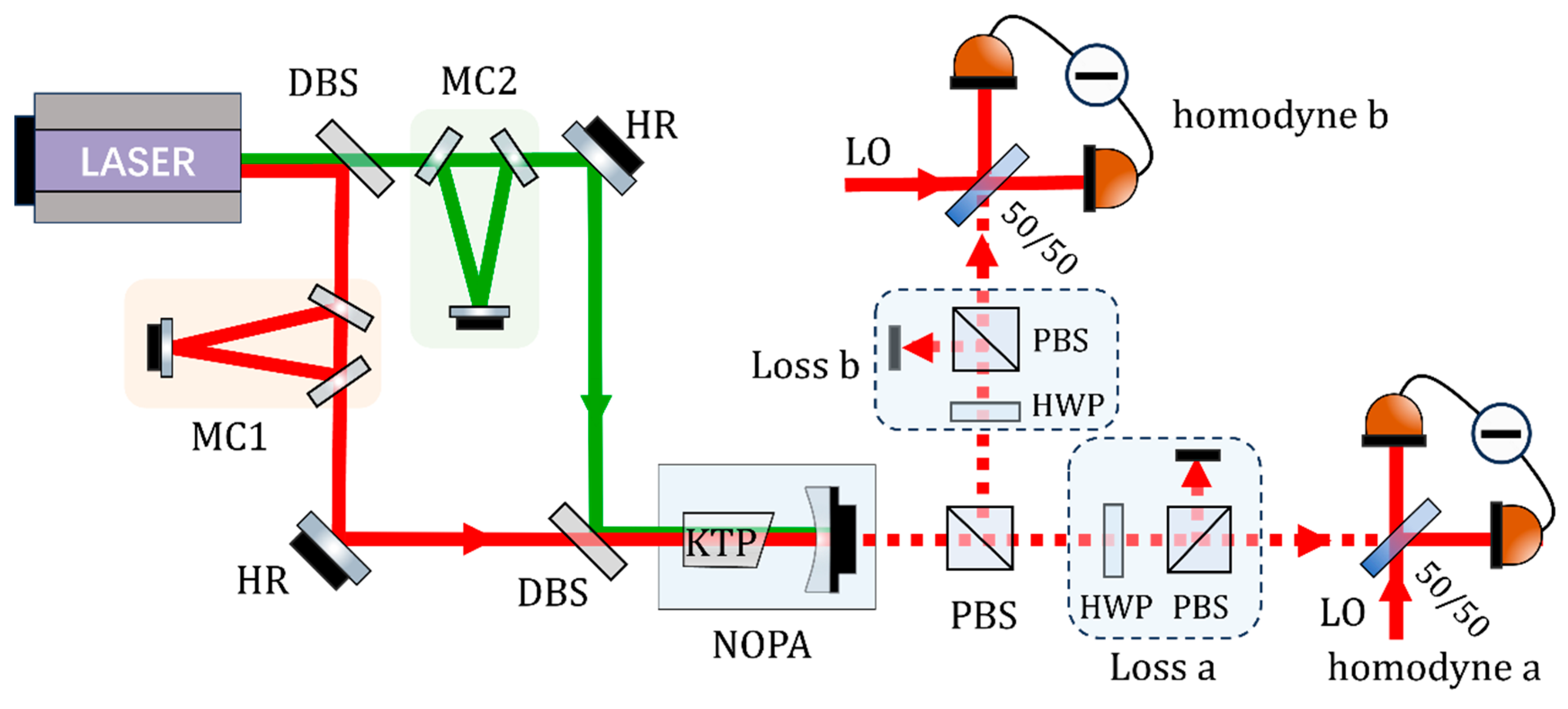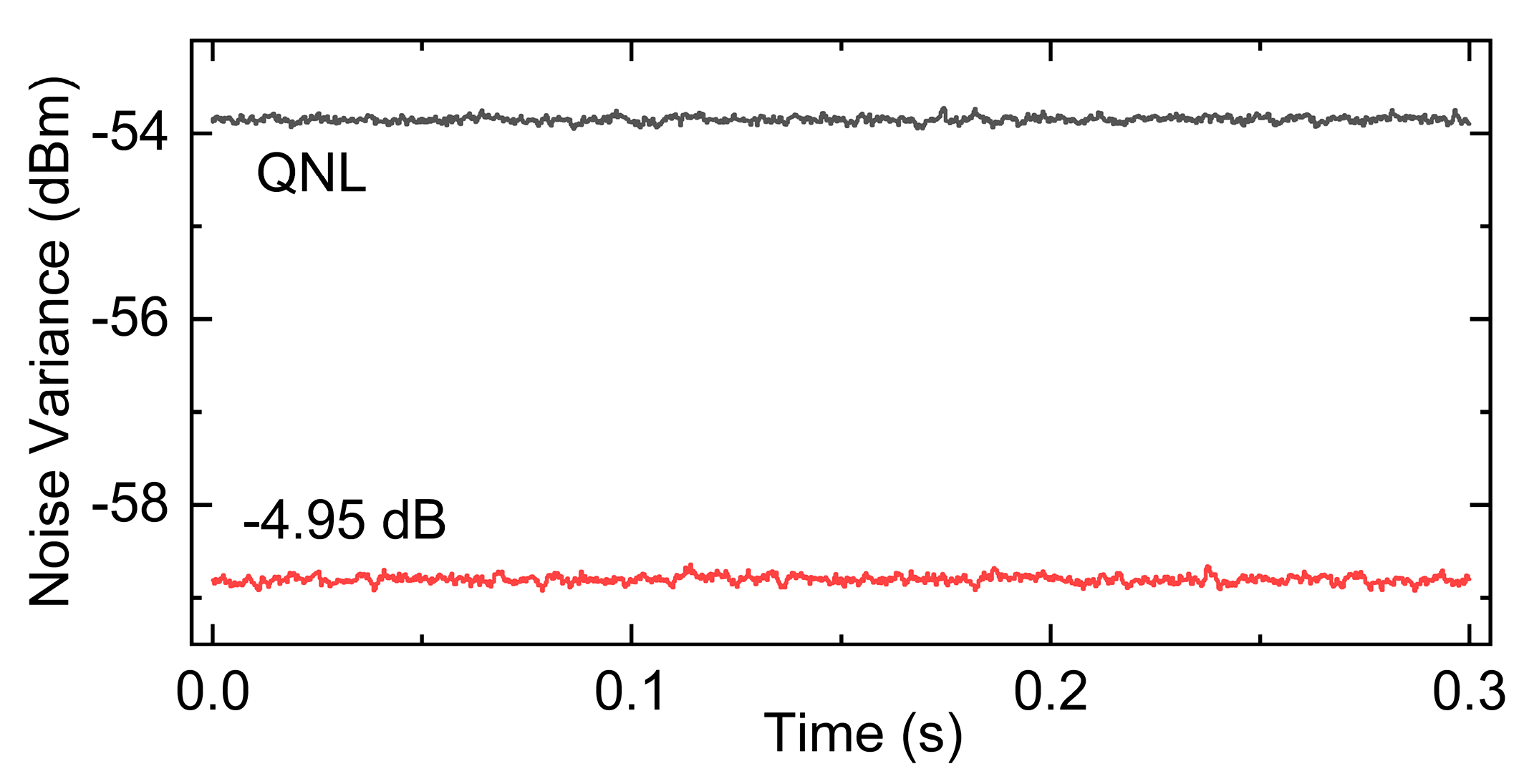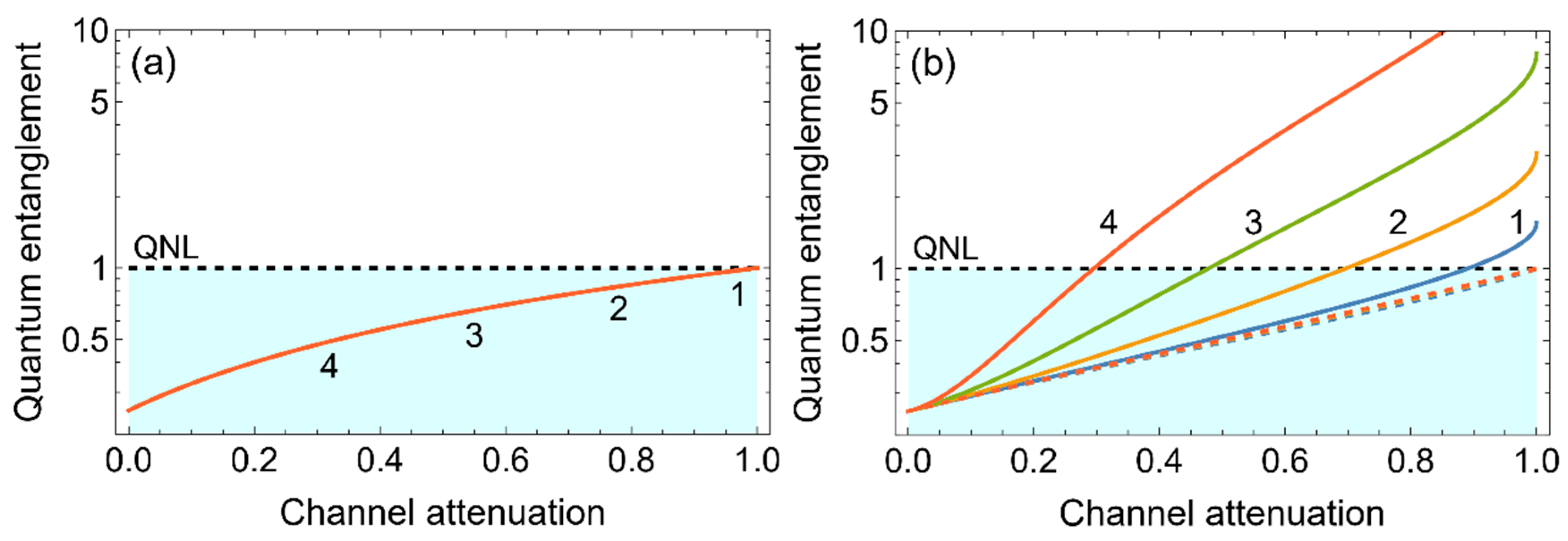Submitted:
30 October 2024
Posted:
31 October 2024
You are already at the latest version
Abstract
Keywords:
Introduction
2. Theoretical Analysis
2.1. Asymmetry of Two-Mode Gaussian States
2.2. Missed Detection of Entanglement
3. Experimental and Results
4. Conclusions
Funding
References
- Huang, J., Li, X., Chen, X. et al.,: Demonstration of hypergraph-state quantum information processing. Nat Commun 15, 2601 (2024). [CrossRef]
- Blais, A., Girvin, S.M. & Oliver, W.D.: Quantum information processing and quantum optics with circuit quantum electrodynamics. Nat. Phys. 16, 247–256 (2020). [CrossRef]
- Li, W., Zhang, L., Tan, H. et al.: High-rate quantum key distribution exceeding 110 Mb s–1. Nat. Photon. 17, 416–421 (2023). [CrossRef]
- Chen, YA., Zhang, Q., Chen, TY. et al.,: An integrated space-to-ground quantum communication network over 4,600 kilometres. Nature 589, 214–219 (2021). [CrossRef]
- Zapatero, V., van Leent, T., Arnon-Friedman, R. et al.: Advances in device-independent quantum key distribution. npj Quantum Inf 9, 10 (2023). [CrossRef]
- Maring, N., Fyrillas, A., Pont, M. et al.,: A versatile single-photon-based quantum computing platform. Nat. Photon. 18, 603–609 (2024). [CrossRef]
- Zhang Z S, You C, Magaña-Loaiza O S et al.,: Entanglement-based quantum information technology: a tutorial. Advances in Optics and Photonics, 16(1), 60-162. (2024). [CrossRef]
- Barbosa, F., Coelho, A., de Faria, A. et al.,: Robustness of bipartite Gaussian entangled beams propagating in lossy channels. Nature Photon 4, 858–861 (2010). [CrossRef]
- C. W. Sandbo Chang, A. M. Vadiraj, J. Bourassa, B. Balaji, C. M. Wilson: Quantum-enhanced noise radar. Appl. Phys. Lett. 114 (11): 112601 (2019). [CrossRef]
- Karsa, Athena, Ghalaii Masoud and Pirandola Stefano.: Noiseless linear amplification in quantum target detection using Gaussian states. Quantum Sci. Technol. 7 035026 (2022). [CrossRef]
- Gonzalez-Raya, T., Pirandola, S. & Sanz, M.: Satellite-based entanglement distribution and quantum teleportation with continuous variables. Commun Phys 7, 126 (2024). [CrossRef]
- N. Hosseinidehaj, Z. et al.,: Satellite-Based Continuous-Variable Quantum Communications: State-of-the-Art and a Predictive Outlook. IEEE Commun. Surv. Tutor. 21 881-919 (2019). [CrossRef]
- Steinlechner S, Bauchrowitz J, Eberle T, Schnabel R: Strong Einstein-Podolsky-Rosen steering with unconditional entangled states. Phys. Rev. A 87 022104 (2013). [CrossRef]
- Reid M D, Drummond P D.: Quantum correlations of phase in nondegenerate parametric oscillation. Phys Rev Lett. 60(26):2731-2733 (1988). [CrossRef]
- Simon R: Peres-Horodecki separability criterion for continuous variable systems. Phys. Rev. Lett. 84 2726 (2000). [CrossRef]
- Tserkis S, Ralph T C: Quantifying entanglement in two-mode Gaussian states. Phys. Rev. A 96 062338 (2017). [CrossRef]
- Duan L M, Giedke G, Cirac J I, Zoller P: Inseparability Criterion for Continuous Variable Systems. Phys. Rev. Lett. 84 2722 (2000). [CrossRef]
- Fedrizzi, A., Ursin, R., Herbst, T. et al.,: High-fidelity transmission of entanglement over a high-loss free-space channel. Nature Phys 5, 389–392 (2009). [CrossRef]
- Xu, JS., Xu, XY., Li, CF. et al.,: Experimental investigation of classical and quantum correlations under decoherence. Nat Commun 1, 7 (2010). [CrossRef]
- Deng, X., Liu, Y., Wang, M. et al.,: Sudden death and revival of Gaussian Einstein–Podolsky–Rosen steering in noisy channels. npj Quantum Inf 7, 65 (2021). [CrossRef]
- Li F, Li T, Agarwal G S: Experimental study of decoherence of the two-mode squeezed vacuum state via second harmonic generation. Phys. Rev. Res. 3 033095 (2021). [CrossRef]
- Buono D, Nocerino G, Porzio A, Solimeno S: Experimental analysis of decoherence in continuous-variable bipartite systems. Phys. Rev. A 86 042308 (2012). [CrossRef]
- Bowen W P, Schnabel R, Lam P K, Ralph T C: Experimental investigation of continuous-variable quantum teleportation, Phys. Rev. Lett. 90 043601 (2003). [CrossRef]
- Chunxiao Cai, Long Ma et al., : Generation of a continuous-variable quadripartite cluster state multiplexed in the spatial domain. Photon. Res. 6 479-484 (2018). [CrossRef]
- Juan Li, Jiaming Li, Chunxiao Cai et al.,: Enhancement of continuous-variable hyperentanglement by optimizing pump mode. Acta Phys. Sin. 68 034204 (2019). [CrossRef]
- G. Masada: Evaluation Method for Inseparability of Two-Mode Squeezed Vacuum States in a Lossy Optical Medium. Tamagawa University Quantum ICT Research Institute Bulletin, 5(1) 19-23 (2015).
- Masada G: Two-mode squeezed light source for quantum illuminaiton and quantum imaging II, Proc. SPIE 9980 Quantum Commun. Quantum Imaging XIV 99800T (2016).
- Masada G: Verification of quantum entanglement of two-mode squeezed light source towards quantum radar and imaging. Proc. SPIE 10409 Quantum Commun. Quantum Imaging XV 104090P (2017).
- Masada G: Non-Classical Correlation of Asymmetric Two-Mode Squeezed Vacuum states. Tamagawa University Quantum ICT Research Institute Bulletin 7 33 (2017).
- Masada G: Non-classical correlation of two-mode squeezed light in asymmetric optical-loss conditions. Proc. SPIE 10771 Quantum Commun. Quantum Imaging XVI 107710I (2018).
- Jinxia Feng, Zhenju Wan et al.,: Distribution of continuous variable quantum entanglement at a telecommunication wavelength over 20 km of optical fiber. Opt. Lett. 42 3399-3402 (2017). [CrossRef]
- Hao Zhao, Jinxia Feng et al.,: Entanglement robustness of continuous variable Einstein-Podolsky-Rosen-entangled state distributed over optical fiber channel. Acta Phys. Sin. 71 (2022). [CrossRef]
- Wenhui Zhang, Ruixin Li et al.,: Security analysis of continuous variable quantum key distribution based on entangled states with biased correlations. Opt. Express 29 22623-22635 (2021). [CrossRef]
- David Luong, Bhashyam Balaji: Quantum two-mode squeezing radar and noise radar: covariance matrices for signal processing. IET Radar Sonar Navig. 14 97 (2020). [CrossRef]
- Quntao Zhuang: Quantum Ranging with Gaussian Entanglement. Phys. Rev. Lett. 126 240501 (2021). [CrossRef]
- Cyril Branciard, Eric G. Cavalcanti et al.,: One-sided device-independent quantum key distribution: Security, feasibility, and the connection with steering. Phys. Rev. A 85 010301 (2012). [CrossRef]
- Katherine Wagner, Jiri Janousek et al.,: Asymmetric EPR entanglement in continuous variable systems. J. Phys. At. Mol. Opt. Phys. 47 225502 (2014). [CrossRef]
- Bowen, W. P., Lam, P. K., & Ralph, T. C.: Biased EPR entanglement and its application to teleportation. 2003 J. Mod. Opt. 50 801–813 (2003). [CrossRef]
- Zhao J: Post-selection-based continuous variable quantum information processing. PhD thesis Australian National University 2019.
- M. Houde, L.C.G. Govia, and A.A. Clerk: Loss Asymmetries in Quantum Traveling-Wave Parametric Amplifiers. Phys. Rev. Applied 12 034054 (2019). [CrossRef]
- Spyros Tserkis, Jayne Thompson et al.,: Maximum entanglement of formation for a two-mode Gaussian state over passive operations. Phys. Rev. A 102 052418 (2020). [CrossRef]
- Xiaoting Gao, Mathieu Isoard et al.: Correlation-Pattern-Based Continuous Variable Entanglement Detection through Neural Networks. Phys. Rev. Lett 132 220202 (2024). [CrossRef]






Disclaimer/Publisher’s Note: The statements, opinions and data contained in all publications are solely those of the individual author(s) and contributor(s) and not of MDPI and/or the editor(s). MDPI and/or the editor(s) disclaim responsibility for any injury to people or property resulting from any ideas, methods, instructions or products referred to in the content. |
© 2024 by the authors. Licensee MDPI, Basel, Switzerland. This article is an open access article distributed under the terms and conditions of the Creative Commons Attribution (CC BY) license (http://creativecommons.org/licenses/by/4.0/).




